Bill S offers his point of view on Day Three (July 23) of Outdoor Retailer.
Nikon
Thursday morning started early in the morning by joining the Audubon Society's birding trek to the Inland Sea Shorebird Reserve. We were joined by a representative of Nikon's binocular division who loaned us each a pair of the new Nikon EDG binoculars. Having used Nikon cameras and binoculars for many years, I expected the binoculars to be good, but to say the least, I was blown away. And these weren't even the vibration-reduction version!
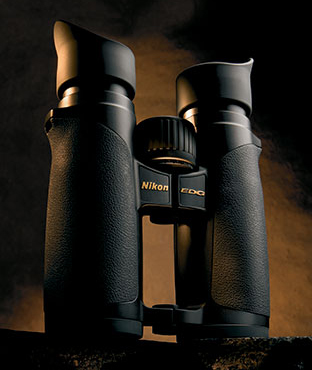
Nikon EDG binoculars.
The birding itself was great, with the very first bird we spotted on entering the Reserve being a golden eagle. The many birds spotted included avocets, killdeer, snowy plover, gadwalls, willets, ibis, pelicans, and three different kinds of gull. At the end, I tried to stuff the binoculars in my pack, but had to give them back. By the way, the various versions of EDG range in price from $1,600 to more than $2,000.
After recovering from sticker shock and thinking about it, I will have to say that these were such a huge step up from my older 7x50 Nikon binoculars that they are well worth it if you are an avid birder. And if you aren't an avid birder, it wouldn't take very many jaunts with your local Audubon expert to get hooked with something this good. (No, I have no connection with Nikon other than using their gear, and they seem to be resistant to just giving me a pair of their binoculars — maybe I ought to be sour grapes).
I was getting pretty puzzled about my problems with the Salt Palace's wifi connection until I found that others, including the vendors (on a supposedly separate system) were having lots of problems as well. So the last two days of reports are coming out after the show has closed. I am also adding a few revisits here.
Superfeet
I revisited the Superfeet booth to get the full explanation for the eight colors of Superfeet. Although to some extent it is marketing, the colors are also color coding for usage. Note that all feature antimicrobial top fabrics:
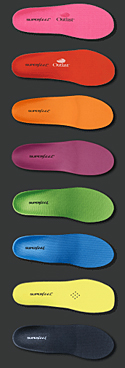 Hot Pink: intended for women's ski boots, these are heat retaining.
Hot Pink: intended for women's ski boots, these are heat retaining.
Hot Red: same as above, but men's ski boots.
Orange and Berry: for running shoes, these two have a curved last, and narrower heel, and cushioned forefoot (orange for men, berry for women).
Green: the traditional hiking boot insole with the most heel pocket, and the thickest padding.
Blue: for casual shoes. These add less volume, since most people add these on top of the manufacturer's insole, where other users remove the insole shipped with the footgear. Boot manufacturers normally intend for the user to put in an aftermarket insole, as I and others have noted on Trailspace previously.
Yellow: raised heel profile, intended for cycling shoes and skates (I intend to try these in the near future, since I bicycle a lot).
Black: thinnest, intended for dress shoes and flat feet.
Black DMP (Dynamic Molding Process): these form an impression of the foot from wearing them. They are intended for aging feet and Type II diabetics, as well as others with fairly rapidly changing foot shape.
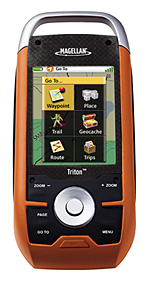
Triton 2000 from Magellan.
Magellan
After participating in the Magellan Geocache contest at the Open Air session (Day Zero), I stopped by their booth to see what was new. Magellan has changed owners several times over the past few years, but the new owners seem to have their eye set on making the best use of Magellan's long history in the consumer GPS receiver market.
A couple years ago, they started a partnership with National Geographic maps, with the current units allowing the uploading of Topo and TrailSmart maps directly onto the Triton units. There were a number of bugs that have now been resolved (I would blame the use of a Microsoft operating system for some of the bugs at least, based on personal experience developing applications using MS products — lest you think this means I am an Apple fan, I have found virtually identical bugs in Apple OS's). The Triton I used during the caching contest worked well, though I was new to the touchscreen interface being used and have yet to see an operating manual.
Rite in the Rain
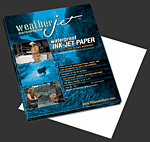
Weatherjet Ink-Jet Paper
Rite in the Rain had a booth at the show this time, which I had not seen before. They produce a line of waterproof papers, which many of us use in notebook form. I like to use their printer paper for the courses in land navigation I teach, and so complained to the folks at the booth about how difficult it is to find the printer version. They told me that I can order directly by going to their website — good to know. Their paper isn't exactly the most glamorous product, but when you are keeping a journal in the rain forest or in the wet winters we have in the Sierra, that's what you need.
Brooks-Range
I visited a number of other booths on Thursday, but most had only incremental changes (or "new colors"), with several others already covered by Alicia. I do want to add something to her comments about Brooks-Range. This company has products primarily aimed at professional guides. They have a range of map tools and guide-oriented gear, such as their emergency sleds and the Rocket Tent that Alicia reported on. Their gear is generally well-made and well-thought out. However, because they are aimed at a niche market and have a small production, their products are, in my personal opinion, over-priced.
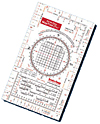
All-in-One Map Tool Pro.
Many of their mapping tools are available at lower prices from vendors in another, related niche market, namely for surveyors and foresters, as well as a wider SAR market. A good source of the map tools (some virtually identical) is Forestry Suppliers, located in Jackson, Mississippi, and with a very complete website. In the SAR and guide niche, NOLS has a lot of the same "guide cards."
However, their rescue sleds are pretty unique as a readily buyable product, though directions for making the same thing on your own (or even improvising on the spot) can be found in a number of backcountry ski and winter camping books. They introduced a rescue sled specifically for snowboarders at the show.
The Rocket Tent is a very interesting product, since it uses the avy probe and adjustable ski poles you will already have with you (it is pretty much a single person tent). I can see some uses for it, though it is a bit on the pricey side.

 by Bill Straka
by Bill Straka









